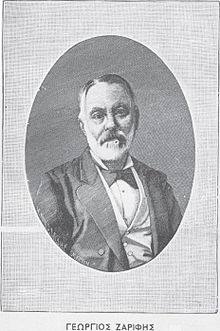Georgios Zariphis
Georgios Zariphis | |
|---|---|
 | |
| Born | Yorgo Zariphis 1810 Constantinople (Istanbul), Ottoman Empire |
| Died | March 28, 1884 |
| Known for | Financier and banker |
Georgios Y. Zariphis (Template:Lang-el, 1810–1884), also known as Yorgo Zarifi, was a prominent Ottoman Greek banker and financier. He was also very well known as a prominent benefactor of his time. Zariphis met Sultan Abdulhamid II when the latter was a shahzade with a low expectation of ascending to the throne. The Prince, having financial troubles, called on the expertise of Zariphis to manage his personal wealth. After Abdulhamid became sultan, he continued to utilize Zarifi's advisory services.
Living at the time when the Ottoman Empire was in great financial distress and had declared bankruptcy, Zariphis was one of the Galata bankers that was involved in the Empire's debt raising. He was also involved in setting up Düyun-u Umumiye (Office of Public Debt) in 1881 that oversaw tax collection and debt payments of the Ottoman Empire.
Zariphis also sponsored the foundation of Greek language schools, which were named Zariphia after schools: like the Zariphios School in Philippopolis (present-day: Plovdiv, Ottoman name: Filibe) and Dede Aghach (present-day: Alexandroupoli).[citation needed]
Traces of Zariphis in Today's Istanbul
One of the buildings of the Balikli Greek Hospital is named Zariphion in his honor, not because of a specific bequest but in remembrance of the many at-large donations he gave during his lifetime. Georgios Zariphis's summer time mansion, Zarifi Köşkü, in the Yeniköy district is a listed and protected historical building, which in 2005 started undergoing renovation as the headquarters of the Turkish Football Federation.[1]
A restaurant in the Beyoğlu district is named Zariphis, both as a play on the word zarif ("genteel") and with reference to Yorgo Zarifi.[2][3]
In September 1955, during the anti-Greek Istanbul riots his grave was vandalized by a fanatical mob.[4]
References
- ^ "Zarifi Kosku" (in Turkish). Tarabya Tarihi (History of Tarabya). Retrieved 11 January 2013.
- ^ "Zarifi Restaurant" (in Turkish). Rezztoran. Retrieved 11 January 2013.
- ^ "An Elegant History". Zarifi: Official Website. Retrieved 11 January 2013.
- ^ "Σεπτέμβριος 1955: η τρίτη άλωση" (PDF). & Ημέρες, Καθημερινή. Retrieved 3 October 2011.
- Zarifi, Georges L. (2002) My Memoirs: a world that has gone, (in Greek) Trohalia Publishing co, Athens Greece, ISBN 960-7809-93-9.
- Zarifi, Yorgo L. (2005), Hatıralarım: Kaybolan Bir Dünya İstanbul 1800-1920, ISBN 975-04-0307-X
